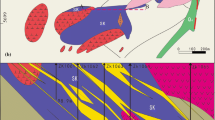Abstract
Sphene is very common in rocks including albitized granite, dioritic porphyrite, calcsilicate rock and breccia from the eastern fold belt of Mount Isa Inlier, Cloncurry. Two stages of sphenes are present in these rocks. First-staged sphene is relatively fine, euhedral, some grains show round or patchy zoning; second-staged sphene is relatively large, anhedral to subhedral, some grains show patchy zoning; both possibly contain rutile, ilmenite and magnetite inclusions. All sphenes are of low-Al type. The second-staged sphene has lesser Fe apfu than the first-staged sphene. Light-color part of the sphene has bigger Fe apfu than the dark-color part, as observed on one individual grain of sphene with patchy zoning, the average XFe of the sphene with patchy zoning is greater than that of the sphene without patchy zoning. Because the sphenes are taken from different types of rocks, Si, Ti, and Al have variable relations with F + OH apfu. Si and Ti are not correlated with OH + F in all analyzed samples; Fe is correlated with OH + F in the sphene just from granite and dioritic porphyrite; Al is correlated with OH + F in the sphene from granite and breccia and is not correlated with OH + F in the sphene from the dioritic prophyrite and calcsilicate rocks. The first-staged sphenes were possibly formed in the processes of magmatism and metamorphism. The second-staged sphenes were formed as a result of the breakdown of hornblendes and biotites in the process of Na (Ca)-metasomatism.
Similar content being viewed by others
References
Corfu F. (1996) Multistage zircon and titanite growth and inheritance in an Archean gneiss complex, Winnipeg River Subprovince, Ontario [J].Earth Planet. Sci. Lett. 141, 175–186.
Corfu F. and Muir T. L. (1989) The Hemlo-Herton Bay greenstone belt and the Hemlo Au-Mo deposits, Superior Province, Ontario, Canada (II): Timing of metamorphism, alteration, and Au mineralization from titanite and monazite U-Pb geochronology [J].Chem. Geol. 79, 201–223.
Deer W. A., Howie R. A., and Zussman J. (1982)Rock-Forming Minerals: 1 Orthosilicates [M]. Longman.
Essex R. M. and Gromet L. P. (2000) U-Pb dating of prograde and retrograde titanite growth during the Scandian orogeny. [J].Geology 28, 419–422.
Fleischer M. (1978) Relation of the relative concentrations of lathanides in titanite to type of host rocks [J].Amer. Mineral. 63, 869–873.
Henderson P. (1980) Rare-earth element partition between sphene, apatite and other coexisting minerals of Kangerdlugssuaq intrusion, E. Greenland [J].Contrib. Mineral. Petrol. 72, 81–85.
Higgins J. B. and Ribble P. H. (1976) The crystal chemistry and space groups of natural and synthetic titanites [J].Amer. Mineral. 61, 878–888.
Huang W. and Rubenach M. J. (1995) Structural controlsyntectonic metasomatic tremolite and tremolite-plagioclase pods, Molanite Valley, Mt. Isa, North Australia [J].Journal of Structural Geology. 17, 83–94.
Mark G. (1998) Albitite formation by selective pervasive sodic alteration of tinalite plutons in the Cloncurry district, NW Queensland [J].Australian Journal of Earth Sciences. 45, 765–774.
Mark G. and de Jong G. (1996) Synchronous granitoid emplacement and episode sodic-calcic alteration in Cloncurry district: Style, timing and metallogenic significance [J].James Cook University EGRU Contribution. 55, 81–84.
Mark G. and Foster D. R. W. (2000) Magmatic-hydrothermal albite-actinolite-apatite-rich rocks from Cloncurry district, NW Queensland, Australia [J].Lithos. 51, 223–245.
Markl G. and Piazolo S. (1999) Stability of high-Al titanite from low-pressure calc-silicates in light of fluid and host-rock composition [J].Amer. Mineral. 84, 37–47.
Oberti R., Rossi G., and Smith D. C. (1985) X-ray crystal structure refinement studies of the TiO ⇋ Al (OH, F) exchange in high-aluminum-sphenes [J].Terra Cognite. 5, 428.
Oberti R., Smith D. C., Rossi G., and Caucia F. (1991) The crystal-chemistry of high-aluminum titanites [J].Eur. J. Mineral. 3, 777–792.
Oliver N. H. S. (1995) Hydrothermal history of Mary Kathleen Fold Belt, Mt. Isa Block, Queensland [J].Australian Journal of Earth Sciences. 2, 267–280.
Page R. W. and Sun S. S. (1998) Aspects of geochronology and crustal evolution in the eastern fold belt Mount Isa Inlier [J].Australian Journal of Earth Sciences. 45, 343–362.
Pan Y. M., Michael M. E., Fleet E., and Macrae N. D. (1993) Late alteration in titanite (CaTiSiO5): Redistribution and remobilization of rare-earth elements for U/Pb geochronology and nuclear waste disposal [J].Geochimica et Cosmochimica Acta. 57, 355–367.
Perkins C. and Wyborn L. (1996) The age of Cu-Au mineralization, Cloncurry district, Mount Inlier, as determined by40Ar/39Ar dating [J].Australian Geological Survey Organization Research Newsletter. 25, 8–9.
Pidgeon R. T., Bosch D., and Bruguier O. (1996) Inherited zircon and titanite O-Pb in Archean syenite from southwestern Australia: Implications for U-Pb stability of titanite [J].Earth and Planetary Letters. 141, 187–198.
Pollard P. J., Mark G., and Mitchell L. C. (1998) Geochemistry of post-1540 Ma granites in the Cloncurry district, Northwest Queensland: Relationships to regional sodic alteration and Cu-Au-Co mineralization [J].Econ. Geol. 93, 1330–1344.
Ribbe P. H. (1980) Titanite. InReview of Mineralogy: 5Orthosilicates [M]. pp. 137–154. Mineralogical Society of America, Washington.
Russell J. K., Groat L. A., and Halleran A. A. D. (1994) LREE-rich niobian titanite from Mount Bisson, British Columbia: Chemistry and exchange mechanisms [J].Can. Mineral. 32, 575–578.
Ventura G. D., Bellatreccia F., and Williams C. T. (1999) Zr-and LREE-rich sphene from Tre Croci Vico volcanic complex (Latium, Italy) [J].Mineral. Mag. 63, 123–130.
Williams P. J. and Philips G. N. (1992) Cloncurry Mapping Project 1990: Geology and the Selwyn Range: James Cook University of North Queensland [J].James Cook University EGRU Contribution. 40, 21.
Williams P. J., Adshead N. D., Blake K. L., de Jong G., Markm G., and Rotherham J. F. (1995) Magnetite-Cu-Au deposits in deeply eroded magmatic arcs: Lessons from Proterozoic terrains [J].Pacrim’95. 631–636.
Zhang L. S. and Sharer U. (1996) Inherited components in magmatic titanite and their consequences for the interpretation of U-Pb ages [J].Earth and Planetary Letters. 138, 57–65.
Author information
Authors and Affiliations
Additional information
Supported by the Key State Basic Research Program of PRC (No. 1999043200).
Rights and permissions
About this article
Cite this article
Ying, H., Pu, C. Occurrence and composition of sphene from eastern fold belt, Mount Isa Inlier, Cloncurry, northwestern Queensland, Australia. Chin. J. Geochem. 24, 18–27 (2005). https://doi.org/10.1007/BF02869685
Issue Date:
DOI: https://doi.org/10.1007/BF02869685



